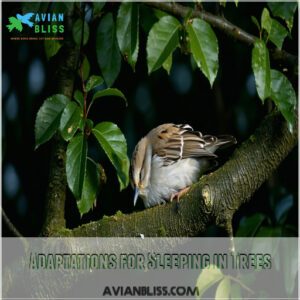This site is supported by our readers. We may earn a commission, at no cost to you, if you purchase through links.

Their legs have a cool built-in feature called a toe-locking mechanism. When a bird bends its leg, tendons automatically tighten, locking its toes around a perch. This keeps them stable without any effort, so they can snooze without falling.
Some birds even sleep on one leg to save energy and conserve body heat—smart, right? This upright posture also helps them stay alert to predators, thanks to a nifty half-brain sleep trick.
Nature really gave birds the ultimate survival toolkit. Curious about their other quirky sleep habits?
Table Of Contents
- Key Takeaways
- Do Birds Sleep Standing Up
- Unique Sleeping Postures in Birds
- How Birds Sleep Without Falling
- Factors Influencing Birds’ Sleep Locations
- Identifying Sleeping Birds
- Birds’ Sleep Patterns Compared to Other Animals
- Why Birds Sleep Differently Than Humans
- Threats and Disturbances to Bird Sleep
- Unique Sleep Adaptations In
- Frequently Asked Questions (FAQs)
- Where do birds sleep?
- Do birds sleep while standing?
- Why do birds not lay down to sleep?
- How long do birds sleep?
- Why do birds sleep on one leg?
- How do birds sleep without falling over?
- Why do birds sleep standing up?
- How do birds sleep without falling?
- Can birds sleep while flying?
- Do birds sleep on branches?
- Conclusion
Key Takeaways
- Birds sleep standing up thanks to a tendon-locking mechanism in their legs that keeps them secure on perches without effort.
- They often sleep on one leg to conserve body heat and energy while staying balanced and alert to predators.
- Unihemispheric slow-wave sleep lets birds rest one brain hemisphere while the other stays awake to watch for threats.
- Their unique sleeping adaptations, like perching mechanisms and upright postures, help them survive and rest efficiently in the wild.
Do Birds Sleep Standing Up
You might think sleeping while standing sounds tricky, but for many birds, it’s perfectly natural.
Thanks to their special leg tendons that lock in place, they can perch securely and rest without worrying about falling.
Advantages of Standing Up for Balance
Birds sleeping upright might seem like magic, but it’s all about balance control.
Their anatomy locks toes onto perches securely, offering stability and safety.
Here’s why bird sleep posture works so well:
- Balanced Sleep Posture: Prevents falling.
- Standing Mechanics: Specialized leg joints lock in place.
- Energy Conservation: Efficient rest.
- Predator Safety: Elevated sleeping spots.
- Quick Reactions: Ready for sudden threats.
Reduced Energy Expenditure on One Leg
Sleeping on one leg isn’t just a quirky bird yoga move—it’s a clever way to save energy.
Thanks to their unique leg anatomy and tendon locking system, birds achieve sleep efficiency while reducing muscle strain.
This posture balances energy conservation and stability, keeping birds standing upright comfortably.
| Benefit | How It Works | Result |
|---|---|---|
| Energy Conservation | Reduces muscle usage | Saves effort while sleeping |
| Balance Control | Tendon locks aid stability | Avoids falling or toppling |
| Sleep Efficiency | Relaxes one leg completely | Rest achieved effortlessly |
The benefits of this posture include energy conservation, balance control, and sleep efficiency, which are crucial for birds to rest while maintaining their balance and stability.
Better Protection From Predators
Predator avoidance is key to bird sleep safety, and their protective postures are brilliant.
Perching high on branches helps them avoid many ground-based predators, while their sleep patterns keep one eye open for added vigilance.
Groups of birds sleeping together boost these strategies—there’s true safety in numbers.
Camouflage adds another layer of defense, blending birds into their environment, it’s like nature’s ultimate hide-and-seek.
Standing tall and alert helps birds react quickly to threats, making them less of an easy snack, with protective postures and added vigilance.
Quick Reaction Time for Flight
When you wonder, "Do birds sleep standing?", it’s all about survival and staying flight-ready.
Their flight reflexes are primed during sleep thanks to their tendon locking system.
This aerodynamic sleep setup provides:
- Quick takeoffs when danger’s near.
- Wing locking keeps muscles primed.
- Unihemispheric sleep allows half the brain to stay alert.
- Avian agility helps spot predators easily.
Anatomical Adaptations for Standing Sleep
Let’s explore the clever tricks bird anatomy has for sleeping upright. Their muscle and tendon arrangement works like a superpower! This avian sleeping behavior demonstrates remarkable adaptation.
- Tendon locking system: Birds’ legs have a built-in locking mechanism. This flexor tendon tightens when they perch, gripping branches effortlessly. No falling here!
- Joint structure and balance control: Special leg joints help them stay stable, even during long snoozes. Their ankles "lock" in place, cutting energy use.
These anatomical adaptations allow birds to perfect their sleep posture, making rest safe and energy-efficient. It’s like nature’s version of cruise control—remarkably efficient and clever!
Unique Sleeping Postures in Birds
Birds have some of the strangest sleep postures you’ll ever see, from standing on one leg to hanging upside down.
These unique positions aren’t just quirky—they help birds stay safe, save energy, and adapt to their environments.
They are important for the birds’ survival, and understanding these postures can provide insights into their behavior.
Standing Up on One or Two Legs
Ever noticed how birds stand on one leg while snoozing? That’s no circus trick—it’s real science! Their bird anatomy has a locking system in their tendons, keeping them steady without effort.
This amazing sleep posture saves energy during standing rest. Here’s a fun fact:
| Feature | Benefit |
|---|---|
| One Leg | Conserves heat |
| Leg Balance | Prevents falling |
| Unihemispheric Sleep | Keeps alert |
| Standing Sleep | Quick escape time |
Why birds sleep standing? It’s survival and stability rolled into one!
Sleeping on Branches and in Trees
Some birds prefer tree perches for their nightly rest.
Branch sleeping offers safety and comfort thanks to clever bird roosting behavior.
Here’s why they love the canopy slumber:
- Roosting groups boost warmth and predator protection.
- Secure spots reduce falling risk with bird sleep adaptations.
- Unihemispheric sleep lets perching birds stay alert while resting.
Birds often use a tree perch system to support their bodies.
Nature’s balance, right?
Perching and Clinging to Bark
Imagine: you’re perched on a sturdy tree trunk, gripping the rough bark with ease.
Birds have an amazing tendon locking system, letting them cling tightly to bark without slipping.
Many perching birds prefer tree perches with textured surfaces for secure limb gripping.
These surfaces suit their bird roosting behavior, ensuring balance during rest.
Whether it’s branch sleeping or trunk resting, their bird sleep postures blend strength, stability, and nature’s clever design effortlessly.
Sleeping While Floating on Water
Here’s a fun question: how do ducks, geese, and other waterbirds pull off a floating rest? Well, thanks to their buoyant bodies and unique bird sleep behaviors, they nap right on the water.
It’s a clever survival strategy!
- Water Sleep: Floating keeps them safe from land predators.
- Marine Doze: Their waterproof feathers provide insulation, so they stay cozy afloat.
- Bird Sleep Positions: They lock their leg ligaments to save energy while drifting.
- Unihemispheric Slow-Wave Sleep: Half their brain stays alert, watching for danger.
This aquatic slumber helps maintain balance between rest and alertness. Truly, nature’s alarm system in action while they enjoy their buoyant dreams!
Hanging Upside Down for Camouflage
Some birds, like parrots and swifts, sleep hanging upside down—a quirky position that doubles as camouflage.
This posture, seen in safe spots like trees, uses their strong branch grip and tendon locking system for stability. It aligns feathers for warmth, deterring predators and blending seamlessly with surroundings.
Frigatebirds can experience in-flight sleep patterns. Such bird sleep positions showcase unique adaptations, from upside-down tree hanging to unihemispheric sleep.
- Camouflage Sleep for predator evasion
- Tree Hanging provides safety
- Bird sleep unique adaptations
- Feather Alignment for warmth
How Birds Sleep Without Falling
Birds have a clever locking system in their legs that keeps them perched securely, even while they’re asleep.
This built-in mechanism works automatically, so they don’t have to worry about toppling over, no matter how soundly they snooze.
Flexor Tendons and Toe Locking
Flexor tendons are nature’s clever safety gear for perching birds.
This tendon locking system lets their toes grip branches like a vice, even during deep sleep.
It’s the secret behind their balance control and standing sleep. The joint locking mechanism means no slipping, no falling—just secure bird sleep positions.
Thanks to tendon mechanics, sleep posture stays steady, making survival look effortless, all due to the remarkable safety gear.
Specialized Leg Anatomy for Perching
A bird’s leg structure is a marvel of engineering.
Thanks to joint locking and tendon anatomy, especially their tendon locking system, perching birds rest without slipping.
Here’s how it works:
- Flexor tendons wrap tightly around perches.
- The tarsus bone stabilizes grip under pressure.
- Thigh bones connect to strong muscles for balance.
- Joints resist flexing during sleep.
- Perching mechanics conserve energy gracefully.
Balance-Sensing Organs and Agility
While specialized leg anatomy helps birds stay stable, their remarkable balance-sensing organs make standing sleep possible.
Beyond the inner ear’s vestibular system, you’ll find a unique balance control center – the lumbosacral organ – in their pelvis.
This dual-balance system offers birds:
- Lightning-fast detection of movement changes
- Perfect equilibrium maintenance while perching
- Coordinated head-body motion during sleep
- Enhanced stability for quick predator escapes
Just imagine having built-in gyroscopes keeping you perfectly balanced all night. Birds also utilize their strong leg muscles to maintain balance and stability while roosting.
Tendon Locking Mechanisms in Owls
While balance organs keep birds steady, owls have evolved an incredible tendon locking system in their feet.
Their unique leg structure features a specialized mechanism that automatically locks their toes around branches when they perch.
You’d be amazed how this owl anatomy lets them sleep standing up without falling, think of it as nature’s seatbelt, keeping these night hunters secure during their daytime rest.
Adaptations for Sleeping in Trees
While owls dazzle us with their nighttime prowess, other feathered friends have mastered the art of tree sleeping too.
You’ll find countless birds dozing peacefully in the canopy shelter, thanks to their remarkable adaptations for branch sleeping.
Here’s how they manage their treetop slumbers:
- A unique tendon locking system grips branches automatically
- Specialized toe pads provide extra grip on tree perches
- Dense leaf cover offers protection from wind and predators
- Strategic trunk resting spots near sturdy limbs provide stability
These clever adaptations, combined with unihemispheric sleep patterns, keep our bird friends safe and cozy in their leafy bedrooms.
Factors Influencing Birds’ Sleep Locations
You’ll find that birds don’t just pick any random spot to catch their Z’s, as they need to evaluate everything from weather and food availability to nearby predators and their flock mates.
Just like you wouldn’t sleep on a busy street or in freezing weather, birds carefully choose their sleep spots based on what’s safest and most comfortable for their specific needs, which makes their choice of resting place quite carefully considered.
Environmental Factors and Weather
Down through the branches and high in the treetops, weather patterns play an essential role in where birds choose to rest.
Temperature effects and humidity levels can dramatically impact their sleep quality, pushing them to seek sheltered spots away from harsh elements.
During storms, they’ll tuck themselves behind natural wind barriers like dense foliage or rock formations.
Climate change poses new challenges, forcing birds to adapt their sleeping positions and locations seasonally.
Just as you’d avoid sleeping in the rain, birds instinctively seek protected spots for their nightly rest, and this behavior is influenced by their instinct to avoid harsh elements.
Availability of Food and Water
Birds carefully choose their sleep locations based on food sources and water quality, just like you’d pick a hotel near restaurants.
Their foraging strategies influence where they rest, ensuring they conserve energy between feeding sessions.
Here’s how birds select their sleeping spots:
- They prefer areas with abundant nutrient availability near reliable water sources
- Many species roost close to their favorite foraging grounds
- Seasonal changes in food patterns affect their sleep locations
- Bird sleep patterns adjust based on feeding habits and resource availability
This smart strategy helps them thrive!
Predation Pressure and Safety
While searching for their nightly rest spots, predator avoidance shapes where you’ll find sleeping birds.
They’ve mastered survival tactics by choosing elevated perches or dense foliage that shields them from hungry eyes.
Thanks to unihemispheric sleep, they’ll keep one brain hemisphere alert while resting the other, demonstrating nature’s clever roosting strategies, and this remarkable vigilance behavior lets them detect threats while getting much-needed shuteye.
Social Structure and Communal Sleep
When darkness falls, nature’s instinct drives countless feathered friends to gather in communal roosts, where shared warmth and watchful eyes create a protective sanctuary.
You’ll notice these fascinating roosting patterns across various species:
- Sociable weavers build massive community nests housing hundreds
- Starlings form spectacular pre-sleep murmurations for safety
- Tree swallows huddle together on reeds and branches
- European robins share dense shrubs during winter nights
- Purple martins crowd together in specially designed houses
Migration Patterns and Sleep
While soaring across vast distances, migrating birds have mastered an incredible balance between flight rest and navigation.
During their epic journeys, you’ll notice these remarkable creatures using unihemispheric sleep, where one brain hemisphere remains alert while the other rests.
They’ll take strategic breaks at specific altitudes, choosing safe spots along migration routes to catch proper sleep.
This clever adaptation helps them maintain their sleep cycles without compromising their journey’s timing or safety from predators, which underscores bird sleep evolution’s incredible efficiency.
Identifying Sleeping Birds
You’ll find it easier to spot sleeping birds once you know their telltale signs, like tucked heads, puffed feathers, and closed eyes.
While some birds take quick power naps during the day, you’re more likely to catch them sleeping at dawn or dusk when they’re settling in for longer rest periods, which can be considered quick power naps or longer rest periods.
Visual Cues and Behavioral Signs
You’ll know a bird’s catching some z’s by watching for these telltale signs:
- Their eye closure happens gradually, with one eye often staying partially open – that’s unihemispheric sleep in action!
- Notice the head tilt as they tuck their beak beneath wing feathers
- Look for extra feather fluff as they puff up for warmth
- Spot their leg locking mechanism engaging as they settle into a cozy perch
These bird sleep behaviors might seem subtle, but once you know what to look for, you’ll become an expert at spotting our feathered friends at rest with their unique behaviors like eye closure.
Posture and Body Position
Three distinct sleeping postures reveal when birds are truly at rest.
You’ll notice their body alignment shifts as they enter different stages of sleep, with most birds maintaining perfect balance mechanisms while standing up.
During upright sleeping, they’ll often tuck one leg close to their body, using specialized tendons for stability.
Watch for subtle changes in their resting positions – from the way they angle their heads to how they nestle their wings.
These bird sleep positions showcase remarkable adaptations for standing sleep and secure perching.
Eye Movement and Eyelid Closure
Birds display fascinating eye behaviors during sleep that you might miss without careful observation.
Here’s what to watch for:
- Eyelid patterns reveal their rest state – some birds doze with partially closed lids while others showcase subtle lid twitches
- Many species master unihemispheric sleep, keeping one eye alert while the other rests
- Watch for pupil contraction and blink patterns – even sleeping birds adjust their gaze
Look closely, and you’ll discover nature’s remarkable sleep adaptations at work, and understand the importance of careful observation.
Breathing Patterns and Heart Rate
When you spot a sleeping bird, you’ll notice fascinating changes in their breathing patterns and heart rate.
During rest, their respiratory rates slow dramatically, with heartbeat variations becoming gentler and more rhythmic.
Here’s what you might observe:
| State | Breathing Pattern | Heart Response |
|---|---|---|
| Awake | Rapid, variable | 400-800 bpm |
| Light Sleep | Steady, slower | 300-600 bpm |
| Deep Sleep | Very slow, regular | 200-400 bpm |
Like us, birds experience sleep apnea and breathing rhythms that signal different sleep cycles. Their cardiac responses adjust to conserve energy while maintaining essential body functions, which is a critical aspect of their overall physiological well-being.
Vocalizations and Sound Patterns
You’ll hear more than just gentle breathing when monitoring sleeping birds. During bird sleep, they produce fascinating sound waves and vocalizations, from soft chirps to complete songs. Through vocal learning, many species communicate even while dozing!
- Different bird songs emerge during various sleep stages, creating unique call patterns
- Some birds practice their songs while sleeping, similar to humans talking in their sleep
- Roosting birds often make quiet "contact calls" to stay connected with their group
- Perching birds may produce soft chirps during unihemispheric sleep, keeping one brain hemisphere alert
These nighttime melodies tell us fascinating stories about avian rest patterns, and highlight the importance of bird sleep and avian rest.
Birds’ Sleep Patterns Compared to Other Animals
You’ll be amazed to learn that birds can sleep with half their brain awake, unlike most mammals who need their entire brain to rest at once.
While you’re snoozing away in your cozy bed, many birds are catching their z’s standing up on one leg, using special leg locks that keep them from falling over.
Unique Hemispheric Slow-Wave Sleep
You’ve probably wondered how birds stay alert while sleeping.
Their secret lies in hemispheric slow-wave sleep – a remarkable neural adaptation where one brain hemisphere rests while the other remains vigilant.
Here’s what makes this brain balancing act amazing:
- Birds maintain constant awareness of their surroundings
- Their sleep patterns allow for quick predator response
- This hemispheric balance helps preserve energy while staying safe
It’s nature’s perfect compromise between rest and survival, allowing birds to stay safe with constant awareness.
Unihemispheric Slow-Wave Sleep (USWS)
Ever wondered how birds stay awake and asleep all at once?
With unihemispheric slow-wave sleep (USWS), they rest one brain hemisphere while the other stays alert. This trick helps dodge predators mid-flight or standing up.
Check out these cool details:
| Feature | Sleeping Half | Awake Half | Benefit |
|---|---|---|---|
| Brain Hemispheres | One side rests | Other side watches | Predator avoidance |
| Sleep Patterns | Half asleep | Half alert | Maintains flight direction |
| Bird Vigilance | Balanced rest | Alert defense | Avoids dangers |
| USWS Mechanisms | Neural adaptability | Quick reaction | Protects health |
That’s clever avian sleep behavior!
Limited Rapid Eye Movement (REM) Sleep
Birds don’t enjoy deep dream states like you do.
Instead, their REM patterns are brief, skipping intense eye movement stages.
Thanks to unihemispheric sleep, they balance resting with sharp alertness.
Their simplified brain waves and short sleep cycles trade dreamy flights for survival.
This quirky avian sleep behavior keeps birds rested enough to dodge predators—call it nature’s quick power nap!
Differences in Sleep Cycles and Durations
Bird sleep cycles are pretty unique!
Instead of deep dream activity like us, they rely on unihemispheric sleep, where one brain half rests while the other stays alert.
Their sleep stages are short, skipping lengthy cycles.
Plus, birds align their cycle durations with sunlight.
This avian sleep trick keeps them safe while maximizing rest physiology during brief, efficient snoozes!
Adaptations for Survival in The Wild
In the wild, survival tactics are everything, and birds have some pretty genius ones up their feathers.
One standout adaptation is unihemispheric sleep, where they rest one brain hemisphere while the other stays alert—perfect for staying sharp against predators.
This clever bird sleep adaptation keeps them ready to fly in an instant.
Add strategic camouflage, smart nesting, and avian balance during rest, and you’ve got top-tier wildlife strategies.
Whether it’s bird migration or predator vigilance, birds truly master survival.
Why Birds Sleep Differently Than Humans
You sleep stretched out in a comfy bed.
Their brains, bodies, and habits are designed for survival, letting them sleep standing, on one leg, or even with half their brain awake, but birds have evolved incredible ways to rest while staying alert.
Evolutionary Pressures and Adaptations
You might wonder why bird sleep is so unique.
Through natural selection, birds evolved adaptive traits for survival.
Their bird anatomy, like flexor tendons, locks them securely on branches.
Thanks to evolutionary adaptations, these traits counter environmental pressures and help conserve energy—like standing on one leg to rest.
Plus, unihemispheric slow-wave sleep lets half the brain stay alert, watching for predators.
Bird sleep physiology is all about balancing rest and readiness!
Brain Structure and Function
A bird’s brain is a sleep science wonder, blending rest with alertness.
Birds exhibit surprising avian cognitive abilities.
- 1. Neural control guarantees one hemisphere naps (unihemispheric slow-wave sleep), while the other stays aware.
- 2. Memory consolidation happens even during short sleeps, sharpening instincts.
- 3. Unique cognitive functions allow survival on minimal REM sleep—a trade-off nature perfected for safety and efficiency.
Sleep Cycles and Patterns
Ever noticed how bird sleep patterns differ from ours?
Their circadian clock manages short rest patterns called microsleeps, letting them stay alert.
Birds even dream during unihemispheric slow-wave sleep, keeping one eye open for safety.
Cool, right?
Check out this quick comparison below:
| Human Sleep | Bird Sleep |
|---|---|
| 8-hour cycle | Short microsleeps |
| REM sleep | Minimal REM |
| Deep sleep | Unihemispheric sleep |
| Full-body rest | Standing up |
| Predictable | Adaptable rhythms |
Physiological and Behavioral Differences
It’s amazing how bird sleep balances survival and rest.
Unihemispheric sleep lets one brain side stay awake while the other naps—imagine snoozing and watching your back!
Birds’ brain structure keeps them alert during brief sleep patterns, unlike our deep slumbers.
Their clever physiological adaptations and hormone regulation conserve energy, making roosting on one leg or perching seem effortless.
What multitaskers!
Curious to Learn About Bird Sleep
A bird brain handles sleep differently!
Birds use unihemispheric sleep cycles, keeping one eye open while half their brain rests.
This clever trick helps during migration or predator threats.
Scientists are still unraveling mysteries like winged dreams.
Bird sleeping habits, like standing up or choosing smart bird sleep locations, show how avian rest balances safety and survival—fascinating and practical, right?
Threats and Disturbances to Bird Sleep
Birds face plenty of challenges regarding getting a good night’s sleep, from sneaky predators to noisy city lights.
These disturbances can mess with their health and survival, making sleep an ongoing balancing act in the wild, which affects their overall survival.
Predation Pressure and Sleep Disruption
Balancing sleep and staying safe from predators is a real juggling act for birds.
They rely on predator avoidance strategies like sleeping perched high or floating away from threats. Many use unihemispheric sleep, resting one brain half while staying alert with the other.
These survival strategies help manage bird sleep threats like predation pressure and sleep fragmentation to maintain rapid threat response.
Environmental Noise and Light Pollution
In urban environments, sleeping birds face challenges like noise pollution and light exposure.
Constant city sounds act as auditory masks, muffling predator warnings.
Meanwhile, artificial lights cause visual disturbance, disrupting internal clocks and altering bird sleep patterns.
Products for bird sleep noise reduction can help mitigate these disturbances.
These issues impact bird sleep locations and even unihemispheric sleep birds.
Imagine roosting with headlights flashing—it’s tough!
Such disruptions force birds to rethink where and how they rest safely, due to visual disturbance.
Habitat Destruction and Fragmentation
When habitat loss and fragmentation disrupt ecosystems, birds struggle to find safe roosting or perching spots.
Fragmentation effects can scatter bird sleep locations, leaving them vulnerable to predators.
Wildlife corridors and conservation strategies help reconnect habitats, giving birds a fighting chance. Protecting ecosystems supports bird survival while supporting their role in maintaining balance—like nature’s team players getting a good night’s rest, which is crucial for their overall survival and allows them to thrive as nature’s team players.
Climate Change and Sleep Adaptations
Climate change is throwing a wrench in how birds rest and recover.
Shifting seasons and unpredictable weather mess with their migration patterns and sleep cycles. Rising temperatures disrupt sleeping routines, making energy conservation harder. It’s like birds can’t catch a break!
- Temperature shifts impact sleep quality.
- Sea level rise forces habitat loss.
- Weather extremes add stress.
- Altered migration patterns disrupt rest.
- Increased predator encounters challenge sleep mechanisms.
Adapting through unihemispheric slow-wave sleep helps, but challenges grow.
Human Impact on Bird Sleep Patterns
Human activity doesn’t just ruin your nap; it throws off bird sleep too.
Urbanization and noise pollution blur predator signals, while light disturbance confuses natural rhythms.
Habitat loss from construction shrinks safe sleeping spots.
Additionally, climate change impacts disrupt migration and breeding patterns, impacting sleep.
Add climate change and pesticide exposure, and birds struggle even more.
Without secure sleep locations and behaviors, predators gain the upper hand, making their clever sleep adaptations essential for survival.
Unique Sleep Adaptations In
Birds have some of the coolest sleep adaptations that make you wonder how they pull it off.
Their unique plumage and camouflage adaptations contribute to their survival.
Here are four fascinating examples of how birds sleep:
- Hummingbirds sometimes snooze upside down, looking like tiny trapeze artists hanging from branches.
- Flamingos amaze with one-legged sleeping stances, using it to conserve body heat and balance like expert yogis.
- Parrots enjoy safe, secluded spots to perch while their strong toes and claws keep them steady, even in windy trees.
- During migration, some birds use unihemispheric slow-wave sleep—half their brain stays awake to watch for predators, while the other half catches rest mid-flight!
These bird sleep adaptations show how clever avian physiology is, blending survival, resting behaviors, and defense against predators perfectly!
Frequently Asked Questions (FAQs)
Where do birds sleep?
Let’s not beat around the bush—birds sleep in various places.
Many perch on branches using special feet-locking tendons, while others roost in trees, nests, or even on the ground, depending on their species.
Do birds sleep while standing?
Yes, many birds doze while standing up.
They’ve got a nifty foot-locking system that keeps them balanced without effort.
This allows them to rest safely on branches without worrying about toppling over.
Why do birds not lay down to sleep?
Lying down isn’t practical for most birds because their leg structure makes it harder.
Standing locks their tendons, keeping them balanced and safe on perches.
It’s energy-efficient, avoids predators, and keeps them warmer, too!
How long do birds sleep?
Think of sleep like a pit stop for birds.
Most snooze for 6 to 12 hours daily, varying by species.
Diurnal birds rest at night, while nocturnal ones like owls sleep during daylight hours.
Why do birds sleep on one leg?
Birds sleep on one leg to conserve body heat and energy.
By tucking a leg into their feathers, they minimize heat loss, balance better, and stay alert to predators—like their version of a cozy, vigilant power nap!
How do birds sleep without falling over?
They’ve got a built-in safety lock.
When birds perch, their flexor tendons tighten, locking their feet onto branches.
This clever mechanism keeps them steady, so they can snooze worry-free without tumbling down.
Genius, right?
Why do birds sleep standing up?
Ever wonder why birds snooze standing up?
It’s all about survival!
Their leg tendons lock like a safety clamp, keeping them stable on perches.
This lets them rest, stay alert, and avoid predators.
How do birds sleep without falling?
Birds stay balanced while sleeping using a "locking mechanism" in their feet.
When they perch, their tendons tighten, locking their toes around branches.
It’s like nature’s built-in safety net, so they don’t topple over!
Can birds sleep while flying?
Soaring through the skies, some birds can actually snooze mid-flight!
During long migrations, they use unihemispheric slow-wave sleep, letting half their brain rest while the other stays alert.
It’s like nature’s ultimate autopilot!
Do birds sleep on branches?
Many birds sleep on branches!
They use a built-in “locking” system in their feet, which grips tightly without effort.
This helps them stay balanced and safe, even during the windiest nights, and that’s pretty clever, huh?
Conclusion
Did you know some birds can spend up to 12 hours sleeping while standing?
Their unique adaptations, like the toe-locking mechanism, make it easy for them to perch securely, even snoozing on one leg.
Sleeping upright conserves energy, keeps them alert to predators, and allows for quick takeoff if danger strikes.
Birds truly master survival with these tricks! So, next time you ask, "Do birds sleep standing up?", you’ll know nature’s got their back—literally!
- https://pangovet.com/pet-behavior/birds/do-birds-sleep-standing-up/
- https://a-z-animals.com/animals/lists/animals-that-sleep-standing-up/
- https://chirpforbirds.com/wild-bird-resources/where-do-birds-sleep-at-night/?srsltid=AfmBOopK7Pwim6ilKRC2Hx1ankeIoMkxomWV3IFL5NJ53h-ZFdkPkDH-
- https://www.audubon.org/news/how-can-birds-roost-one-leg
- https://blog.mybirdbuddy.com/post/how-do-birds-sleep-five-incredible-facts-you-probably-didnt-know



















